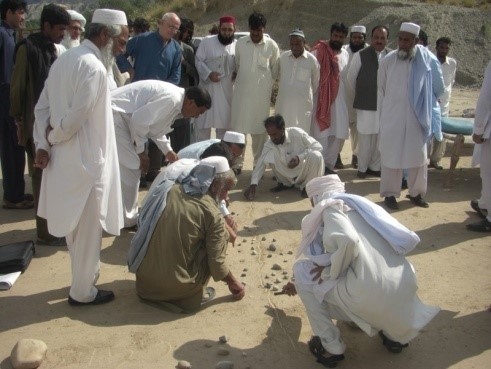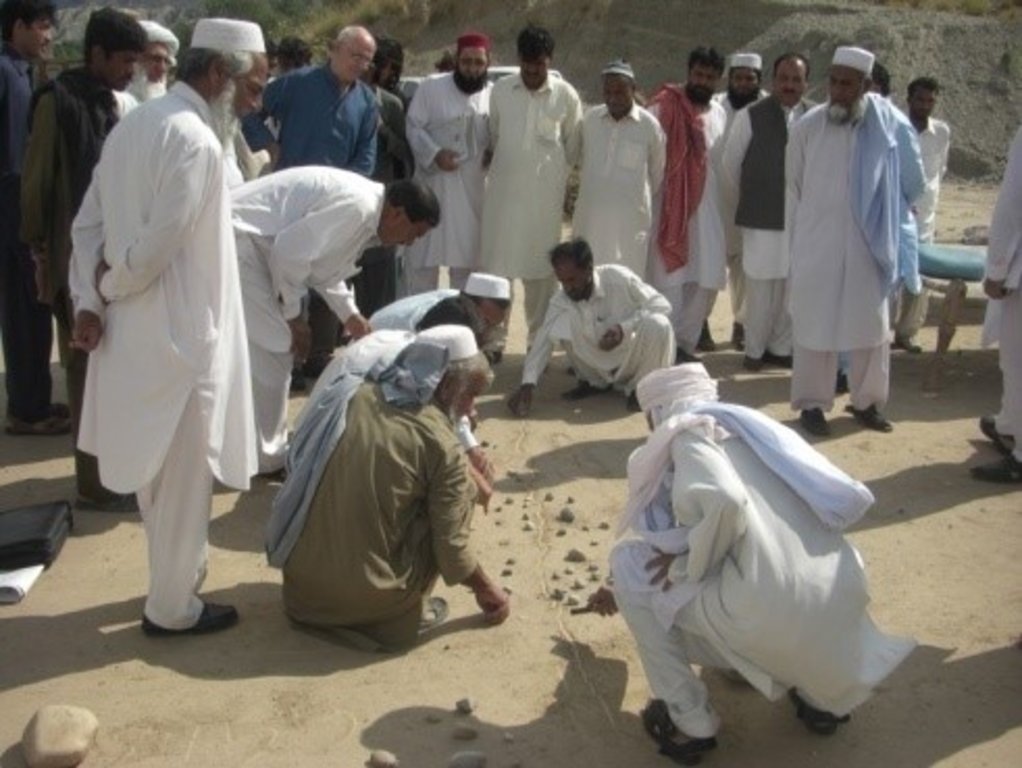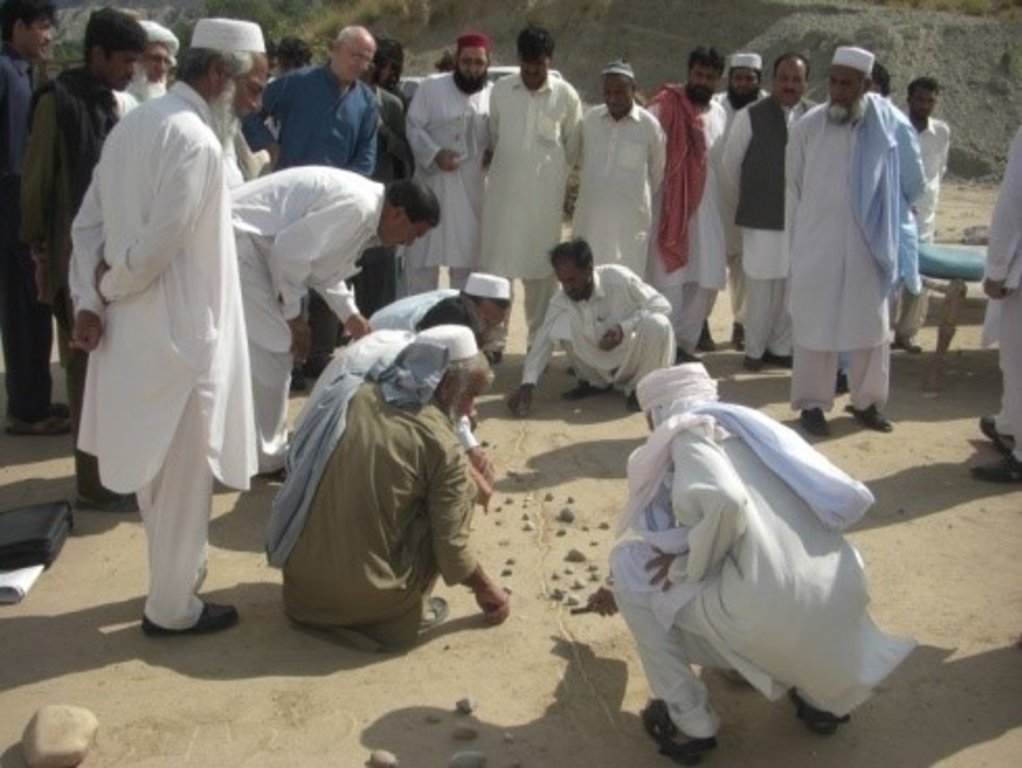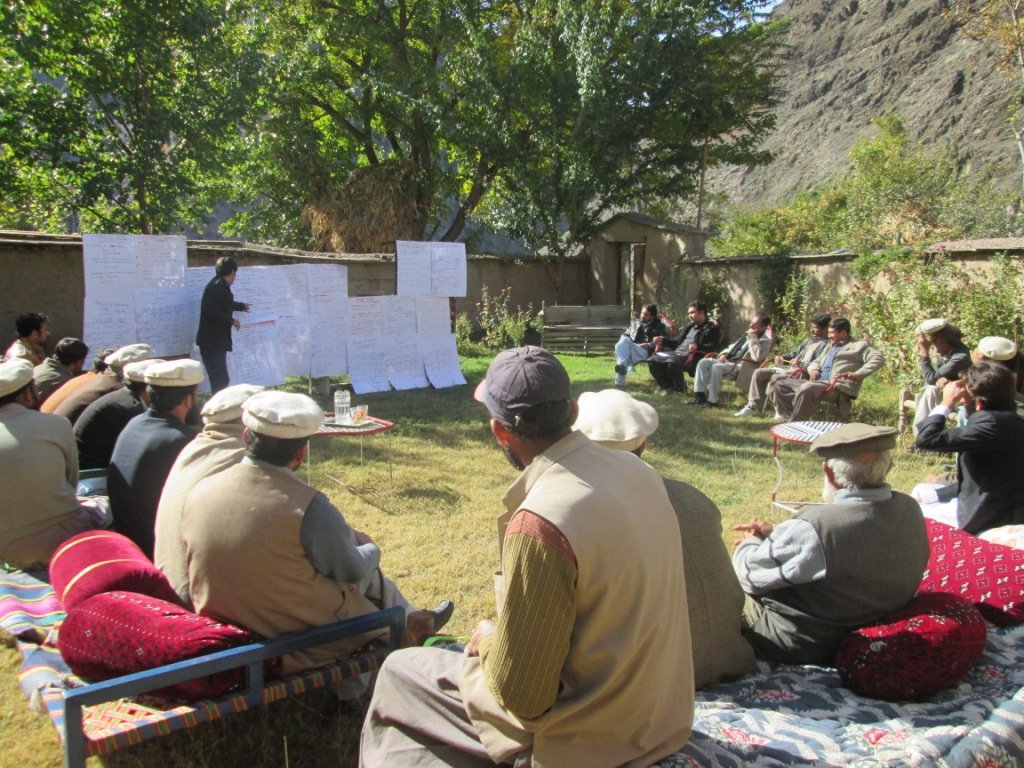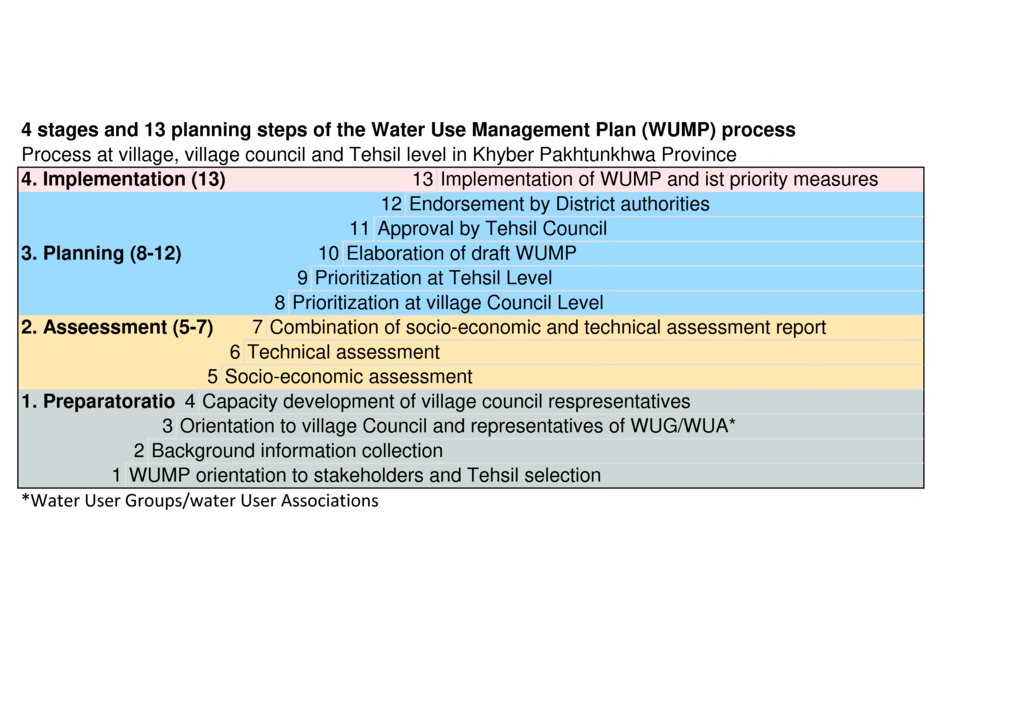Water Use Management Plan (WUMP) [ປາກິດສະຖານ]
- ການສ້າງ:
- ປັບປູງ:
- ຜູ້ສັງລວມຂໍ້ມູນ: Eveline Studer
- ບັນນາທິການ: Munawar Khan
- ຜູ້ທົບທວນຄືນ: Alexandra Gavilano, Nicole Harari, Hanspeter Liniger
WUMP
approaches_747 - ປາກິດສະຖານ
ເບິ່ງພາກສ່ວນ
ຂະຫຍາຍທັງໝົດ ຍຸບທັງໝົດ1. ຂໍ້ມູນທົ່ວໄປ
1.2 ລາຍລະອຽດ ການຕິດຕໍ່ ຂອງບຸກຄົນທີ່ຊັບພະຍາກອນ ແລະ ສະຖາບັນ ການມີສ່ວນຮ່ວມ ໃນການປະເມີນຜົນ ແລະ ເອກະສານ ຂອງວິທີທາງ
ຊື່ຂອງໂຄງການ ທີ່ອໍານວຍຄວາມສະດວກ ໃນການສ້າງເອກກະສານ ຫຼື ປະເມີນດ້ານແນວທາງ (ຖ້າກ່ຽວຂ້ອງ)
Book project: where people and their land are safer - A Compendium of Good Practices in Disaster Risk Reduction (DRR) (where people and their land are safer)ຊື່ຂອງ ສະຖາບັນການຈັດຕັ້ງ ທີ່ອໍານວຍຄວາມສະດວກ ໃນການສ້າງເອກກະສານ ຫຼື ປະເມີນແນວທາງ (ຖ້າກ່ຽວຂ້ອງ)
HELVETAS (Swiss Intercooperation)1.3 ເງື່ອນໄຂ ຂອງການນໍາໃຊ້ເອກກະສານຂໍ້ມູນ ຂອງ WOCAT
ເມື່ອໃດທີ່ໄດ້ສັງລວມຂໍ້ມູນ (ຢູ່ພາກສະໜາມ)?
15/11/2014
ຜູ້ສັງລວມ ແລະ ບັນດາຜູ້ຕອບແບບສອບຖາມ ຍອມຮັບໃນເງື່ອນໄຂ ການນໍາໃຊ້ຂໍ້ມູນເອກະສານ ທີ່ສ້າງຂື້ນ ໂດຍຜ່ານ ອົງການ WOCAT:
ແມ່ນ
1.4 ເອກະສານອ້າງອີງ (ຫຼາຍ) ກັບແບບສອບຖາມ (ຫຼາຍ) ເຕັກໂນໂລຢີ ຂອງດ້ານການຄຸ້ມຄອງ ດິນແບບຍືນຍົງ
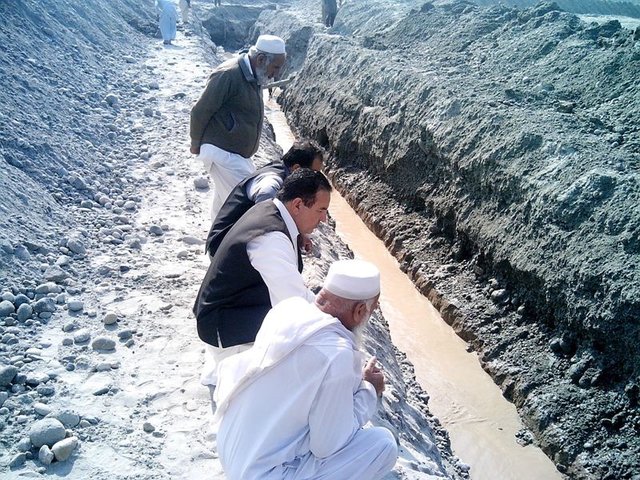
Sub-surface water harvesting for an efficient use of … [ປາກິດສະຖານ]
The purpose of this water harvesting technology is to capture, collect and distribute sub-surface water. First, an infiltration gallery is developed, which allows the percolation and collection of sub-surface water through perforated pipes at a depth of approximately 3-4.5 metres. Sub-surface water is filtered by gravel/sand underground and infiltrates into …
- ຜູ້ສັງລວມຂໍ້ມູນ: Eveline Studer
2. ພັນລະນາ ແນວທາງການຄຸ້ມຄອງນໍາໃຊ້ດິນແບບຍືນຍົງ
2.1 ການອະທິບາຍ ໂດຍຫຍໍ້ ຂອງວິທີທາງ
The overall purpose of WUMP is to compile an inventory of available water ressources in a particular geographical or administrative area, to identify communities' priorities in order to achieve an effective, equitable and efficient use of water resources at local level. This approach promotes a participatory and inclusive analysis and implementation of measures for a sustainable management of water, land and related resources.
2.2 ການອະທິບາຍ ລາຍລະອຽດ ຂອງວິທີທາງ
ການອະທິບາຍ ລາຍລະອຽດ ຂອງວິທີທາງ:
The WUMP approach has the following specific objectives:
- to assess water available resource, existing uses and requirements
- to determine water access rights and equity issues through inclusive and interactive dialogues
- to plan and manage water resources - considering multiple needs and uses - in a participatry manner.
- to prioritise required measures, considering climate change and disaster risks
- to promote coordinated water resource development for different stakeholders
- to promote a sustainable use of water, protecting water resources and preservation of the environment
- to strengthen local institutions
- to include economically and socially disadvantaged groups
- to promote an interactive dialogue for improvement of regulatory frameworks and policies in the water sector.
The methode involves field visits by field team to collect information from the community, which is done through focus group discussion, preparation of village maps, social and technical questionnaires
The WUMP process consists of four main stages: 1) Preparation; 2) Assessment/analysis of information ; 3) Planning ; 4) Implementation (see flow chart with according sub-steps).
The process and results of a WUMP:
Is based on a participatory process, which promote inclusiveness. It fosters coordination and collaboration among different local stakeholders including government, communities and private sector and helps to establish the baseline situation and a comun understanding. Land users and other local actors appreciate this approach as it promotes a participatory, transparent process for an equitable distribution of water and a sustainable management of water related resources. The approach helps to overcome potential economic or socio-cultural barriers, by providing a comun space for joint analysis, discussion and solution finding by facilitating interaction between stakeholders of different contexts.
2.3 ຮູບພາບຂອງແນວທາງ
2.5 ປະເທດ / ເຂດ / ສະຖານທີ່ບ່ອນທີ່ແນວທາງໄດ້ຖືກນໍາໃຊ້
ປະເທດ:
ປາກິດສະຖານ
ພາກພື້ນ / ລັດ / ແຂວງ:
Dera Ismail Khan Thensil (sub-division), Khyber Pakhtunkhwa (province)
Map
×2.6 ວັນທີເລີ່ມຕົ້ນ ແລະ ສິ້ນສຸດ ການຈັດຕັ້ງປະຕີບັດ ວິທີທາງ
ສະແດງປີຂອງການເລີ່ມຕົ້ນ:
2014
ປີທີ່ສີ້ນສູດ (ຖ້າຢຸດບໍ່ໄດ້ນໍາໃຊ້ ວິທີທາງ):
2019
ຄວາມຄິດເຫັນ:
The approach remains valid and applicable also after the termination of a project intervention.
2.7 ປະເພດຂອງແນວທາງ
- ພາຍໃຕ້ໂຄງການ / ແຜນງານ
2.8 ເປົ້າໝາຍ / ຈຸດປະສົງຫຼັກ ຂອງການຈັດຕັ້ງປະຕິບັດ ວິທີທາງ
The main aim of the WUMP approach is to assess the availability of water resources, existing uses/demands and future requirements/needs. The WUMP helps to address water access, equity issues and balance these rights through interactive dialogues within the community and other local stakeholders. The WUMP approach contributes therefore actively to water governance and improved management of natural resources.
2.9 ເງື່ອນໄຂອໍານວຍ ຫຼື ຂັດຂວາງການປະຕິບັດຂອງເຕັກໂນໂລຢີ / ເຕັກໂນໂລຢີການນໍາໃຊ້ຕາມແນວທາງ
ສັງຄົມ / ວັດທະນະທໍາ / ມາດຕະຖານ ແລະ ຄຸນຄ່າທາງສາສະໜາ
- ອໍານວຍ
The approach helps to overcome potential economic or socio-cultural barriers, by providing a comun space for joint analysis, discussion and solution finding by facilitating interaction between stakeholders of different contexts.
ມີຄວາມສາມາດ / ເຂັ້າເຖິງຊັບພະຍາກອນດ້ານການເງິນ ແລະ ການບໍລິການ
- ອໍານວຍ
The implementation of the WUMP tends to increase access to water for production purposes with a positive impact for households/ communities' income.
The results of the WUMP process with its according priorities of intervention are recognized by local government and reflected in local annual development plans and according budgets.
- the WUMP defines options for other actors to investment in water sector based on communities' priorities.
ການກໍ່ຕັ້ງສະຖາບັນ
- ອໍານວຍ
WUMP is steered by the district Coordination Committee at district level having representative from all concerned government departments, Water User Association including women members, representatives from civil society where they adress key issues and take decisionsof the local water sector.
ການຮ່ວມມື / ການປະສານງານຂອງຜູ້ກ່ຽວຂ້ອງ
- ອໍານວຍ
Collaboration among actors is the central element of the WUMP, which pomotes a coordinated water resource development involving different stakeholders: communities and government and non-governmental organizations. The process, enables local institutions to consider needs and participation of economically and socially disadvantaged groups.
ກ່ຽວກັບກົດໝາຍ (ສິດນໍາໃຊ້ດິນ, ສິດນໍາໃຊ້ນໍ້າ)
- ອໍານວຍ
WUMP addresses and defines solutions on water access & equity issues through interactive dialogues.
ນະໂຍບາຍ
- ອໍານວຍ
WUMP can influence sector policies at local level based on the collections of baseline data and evidence, which contributes to improve frame conditions. Topics, priorities and challenges of the WUMP are addressed with stakeholders at district Coordination Committee, which can actively influence policies of the water sector.
ຄວາມຮູ້ກ່ຽວກັບການຄຸ້ມຄອງ ທີ່ດິນແບບຍືນຍົງ, ການເຂົ້າເຖິງການສະໜັບສະໜູນ ທາງດ້ານວິຊາການ
- ອໍານວຍ
The local stakeholders, namely communities are directly involved in the implementation of the WUMP, which improves their knowledge about SLM.
3. ການມີສ່ວນຮ່ວມ ແລະ ບົດບາດຂອງພາກສ່ວນທີ່ກ່ຽວຂ້ອງທີ່ໄດ້ມີສ່ວນຮ່ວມ
3.1 ຜູ້ມີສ່ວນຮ່ວມ ໃນວິທີທາງ ແລະ ພາລະບົດບາດ ຂອງເຂົາເຈົ້າ
- ຜູ້ນໍາໃຊ້ດິນໃນທ້ອງຖິ່ນ / ຊຸມຊົນທ້ອງຖິ່ນ
Rural local communities, water & land users
Participation as an integral part in preparation at village level. Contribution to the assessment, prioritisation and implementation of the interventions
- ອົງການຈັດຕັ້ງ ພາຍໃນຊຸມຊົນ
Water user associations (WUA)/ water users groups (WUG)
Responsible to support and facilitate the WUMP process, social support, provision of primary information. Ensure participation and involvement of all WUA members. Coordinate with relevant authorities and other development actors to identify technical and financial support in their area / water sector.
- ຜູ້ຊ່ຽວຊານ ການນຄຸ້ມຄອງ ທີ່ດິນແບບຍືນຍົງ / ທີ່ປຶກສາດ້ານກະສິກໍາ
staff of the Water for Livelihoods Project : WUMP coordinator (engineer, male, 53 years), senior engineer (engineer, male, 43 years)
Coaching and guidance at all level, steering of WUMP process in collaboration with District Government, organize trainings as scheduled, support field teams for the collection of technical and social information/data.
- ອົງການຈັດຕັ້ງ ທີ່ບໍ່ຂື້ນກັບລັດຖະບານ
Local partner NGO
Project implementation, social mobilisation and interaction at field level to ensure that the social dimension, local concerns deserving support are adressed and that the water user association (WUA) are inclusive and gender concerns are duly represented. Support water user associations in their advocacy efforts to mobilize resources for WUMP.
- ພາກເອກະຊົນ
Consultant
Compilation of data, collected information and writing of WUMP
- ອໍານາດ ການປົກຄອງທ້ອງຖິ່ນ
District Authorities / Administration
Provision of legal and administrative acceptance, recognition and support to WUMP implementation. Support through provision of timely technical services to water user association /groups in WUMP implementation, validation of information (data regarding drinking water supply, irrigation, water use efficiency, soil conservation by Public Health Engineering Department, Irrigation Department, On Farm Water Management Department, Soil Conservation Department ). Participation to ensure a participatory monitoring and provide feedback to the district govt. for improvements in delivering of water sector services.
- ພະນັກງານຂັ້ນສູນກາງ (ຜູ້ວາງແຜນ, ຜູ້ສ້າງນະໂຍບາຍ)
District and provincial governments
Policy dialogue counter-part to address WUMP issues, which require a change in policies, coordination and engagement with in-line authorities and to allocate resources for the integration and implementation of WUMP in the district development plan (ADP).
- ອົງການຈັດຕັ້ງ ສາກົນ
Swiss Agency for Development and Cooperation (SDC)
Financial ressources. Partner for advocacy and policy dialogues to address key topics in the water sector in their policy dialogue with national government representatives.
ຖ້າຫາກມີຫຼາຍພາກສ່ວນທີ່ເຂົ້າຮ່ວມ ໃຫ້ລະບຸ ອົງການທີ່ເປັນຫຼັກ ໃນການຈັດຕັ້ງປະຕິບັດ:
Water for Livelihoods Project
3.2 ການມີສ່ວນຮ່ວມຂອງຜູ້ນໍາໃຊ້ທີ່ດິນໃນທ້ອງຖິ່ນ / ຊຸມຊົນທ້ອງຖິ່ນໃນໄລຍະທີ່ແຕກຕ່າງກັນຂອງແນວທາງ
| ການລວບລວມ ເອົາຜູ້ນໍາໃຊ້ດິນ ໃນທ້ອງຖິ່ນ / ຊຸມຊົນທ້ອງຖິ່ນ | ໃຫ້ລະບຸ ຜູ້ໃດທີ່ມີສ່ວນຮ່ວມ ໃນແຕ່ລະກິດຈະກໍາ? | |
|---|---|---|
| ການເລີ່ມຕົ້ນ / ແຮງຈູງໃຈ | ການຮ່ວມມື | Community through water user association (WUA) and water user group (WUG) in their actvities: support and facilitate the WUMP, ensure that all WUGs are involved in the process, link with relevant authorities and other development actors for technical and financial support development. |
| ການວາງແຜນ | ການຮ່ວມມື | Community: WUA/WUG in their activities: Participate as an integral part in the preparation of WUMP at village level. Contribute to conducting feasibility, implementation and execution of interventions. |
| ການປະຕິບັດ | ການຮ່ວມມື | Community: WUA/WUG in their activities: Support a system for cost contribution by the community. Link with relevant authorities and other development actors for seeking the technical and financial support in their area water sector development. Promote and advocate for sustainable development in the water sector. |
| ຕິດຕາມກວດກາ / ການປະເມີນຜົນ | ການຮ່ວມມື | Community: WUA/WUG in their activities: Ensure equitable water rights and promote good water governance principles. Ensure strong linkages with WUA/community through regular meetings and documentation of decisions. |
3.3 ແຜນວາດ (ຖ້າມີ)
ການອະທິບາຍ:
The process of WUMP is divided into 4 stages consisting of 13 steps
ຜູ້ຂຽນ:
Syed Hussain Mustafa, Khan Muhammad, Tawheed Gul, Munawar Khan Khattak
3.4 ການຕັດສິນໃຈກ່ຽວກັບການຄັດເລືອກເຕັກໂນໂລຢີຂອງການຄຸ້ມຄອງທີ່ດິນແບບຍືນຍົງ / ເຕັກໂນໂລຢີ
ລະບຸ ຄົນທີ່ຕັດສິນໃຈ ກ່ຽວກັບການຄັດເລືອກຂອງ ເຕັກໂນໂລຢີ / ເຕັກໂນໂລຢີ ຈະໄດ້ຮັບການປະຕິບັດ:
- ພາກສ່ວນກ່ຽວຂ້ອງທັງໝົດ, ເປັນສ່ວນໜຶ່ງ ຂອງວິທີທາງແບບມີສ່ວນຮ່ວມ
ອະທິບາຍ:
The technology is selected via mutual consensuses at village council level. This process is facilitated by a SLM specialist. Women - as well as other vulnerable and marginalized groups - are also part of the water user association and participate in the discussion and decision making process. Where joint setting of men & women is not possible due to cultural constraints, separate meetings of men & women are conducted to cover the voices and concerns of both.
Specify on what basis decisions were made:
- ປະເມີນເອກກະສານ ຄວາມຮູ້ກ່ຽວກັບ ການຄຸ້ມຄອງ ທີ່ດິນແບບຍືນຍົງ (ຫຼັກຖານທີ່ຊ່ວຍໃນການຕັດສິນໃຈ)
- ປະສົບການສ່ວນບຸກຄົນ ແລະ ຄວາມຄິດເຫັນ (ທີ່ບໍ່ເປັນເອກກະສານ)
4. ການສະໜັບສະໜູນທາງດ້ານວິຊາການ, ການສ້າງຄວາມສາມາດ, ແລະ ການຈັດການຄວາມຮູ້.
4.1 ການສ້າງຄວາມສາມາດ / ການຝຶກອົບຮົມ
ຜູ້ນໍາໃຊ້ທີ່ດິນ ຫຼື ພາກສ່ວນກ່ຽວຂ້ອງອື່ນໆ ໄດ້ຮັບການຝຶກອົບຮົມບໍ່?
ແມ່ນ
ໃຫ້ລະບຸ ຜູ້ໃດທີ່ໄດ້ຮັບການຝຶກອົບຮົມ:
- ຜູ້ນໍາໃຊ້ດິນ
- ພະນັກງານພາກສະໜາມ / ທີ່ປຶກສາ
- Government department specilist (SLM)
ຮູບແບບຂອງການຝຶກອົບຮົມ:
- ການເຮັດຕົວຈິງ
- ຕົວຕໍ່ຕົວ
- ກອງປະຊຸມ
ໃນຫົວຂໍ້:
Water resources conservation, efficient use of water resources, irrigation water distribution/ scheduling.
ຄວາມຄິດເຫັນ:
Water Users are trained in different techniques of water conservation, such as water crop budgeting, local flow measuring techniques, irrigation scheduling with regard to specific crops.
The users are specifically trained in techniques for efficient water use, such as furrow irrigation, raised bed irrigation, mulching etc.
4.2 ການບໍລິການໃຫ້ຄໍາປຶກສາ
ເຮັດຜູ້ໃຊ້ທີ່ດິນມີການເຂົ້າເຖິງການບໍລິການໃຫ້ຄໍາປຶກສາ?
ແມ່ນ
ລະບຸວ່າການສະໜອງ ການບໍລິການ ໃຫ້ຄໍາປຶກສາ:
- ໃນພື້ນທີ່ຂອງຜູ້ນໍາໃຊ້ດິນ
- ສູນຄົ້ນຄວ້າ
ອະທິບາຍ / ຄວາມຄິດເຫັນ:
SLM specialist made field visits and provided technical guidance to Land Users
The Land Users visited relevant organizations for technical guidance
4.3 ສະຖາບັນການສ້າງຄວາມເຂັ້ມແຂງ (ການພັດທະນາອົງການຈັດຕັ້ງ)
ສະຖາບັນ ໄດ້ຮັບການສ້າງຕັ້ງຂື້ນ ຫຼື ໄດ້ຮັບການສ້າງຄວາມເຂັ້ມແຂງ ໂດຍການຈັດຕັ້ງປະຕິບັດ ວິທີທາງບໍ່?
- ມີ, ພໍສົມຄວນ
ລະບຸ ທາງສະຖາບັນ ໄດ້ສ້າງຄວາມເຂັ້ມແຂງ ໃນລະດັບໃດ (ຫຼາຍ):
- ທ້ອງຖິ່ນ
ອະທິບາຍ ສະຖາບັນການຈັດຕັ້ງ, ພາລະບົດບາດ ແລະ ໜ້າທີ່ຮັບຜິດຊອບ, ສະມາຊິກ ແລະ ອື່ນໆ.
Water User Association (WUA, local Institutions) at district & sub-district level were strengthened. The legally recognize WUA and Apex of the WUA take gradually responsibilities to support and facilitate the WUMP process. The WUAs strives for improvements in the water sector and are a catalyst to bring together and pool communities, civil society organisations, local authorities and other actors of different actors for to address water issues and development options.
ລະບຸ ປະເພດ ຂອງສະໜັບສະໜູນ:
- ການສ້າງຄວາມອາດສາມາດ / ການຝຶກອົບຮົມ
ໃຫ້ລາຍລະອຽດເພີ່ມເຕີມ:
Project provided trainings for 16 Water User Associations (WUAs) and 3 Apex WUAs in Chitral, Karak, and DI Khan. These 16 associations aim to improve development in the water sector, to improve water governance to contribute to resolutions in case of disputes amongst different water right holders for an equitable access to water at local and at district level.
Through these trainings, the WUGs/ WUAs members representing various groups/ associations - including representatives from Government Line Agencies are trained in community management & skill training, mediation in case of water disputes, monitoring/documentation and health/hygiene.
4.4 ຕິດຕາມກວດກາ ແລະ ປະເມີນຜົນ
ການຈັດຕັ້ງປະຕິບັດ ວິທີທາງ ໄດ້ມີການປະເມີນຜົນ ແລະ ຕິດຕາມບໍ?
ແມ່ນ
ຄວາມຄິດເຫັນ:
The principle of the monitoring, is to actively engage the communities associations (WUA/WUG) and capture their observations and concerns.
This is done through direct feedbacks from communities, during regular field visits and interaction with technical departments, who receive feedbacks from communities based on regular exchanges.
ຖ້າແມ່ນ, ເອກກະສານສະບັບນີ້ ແມ່ນໄດ້ນໍາໃຊ້ເຂົ້າໃນການຕິດຕາມ ແລະ ປະເມີນຜົນບໍ່?
ບໍ່ແມ່ນ
ຄວາມຄິດເຫັນ:
This documentation is not primarily used for monitoring & evaluation purpose. However it contributes to establish a baseline.
4.5 ການຄົ້ນຄວ້າ
ນີ້້ແມ່ນສ່ວນໜຶ່ງ ການຄົ້ນຄວ້າ ຂອງວິທີທາງບໍ່?
ບໍ່ແມ່ນ
5. ການສະໜັບສະໜູນທາງດ້ານການເງິນ ແລະ ອຸປະກອນຈາກພາຍນອກ
5.1 ງົບປະມານປະຈໍາປີ ສໍາລັບວິທີທາງ ຂອງການຄຸ້ມຄອງ ທີ່ດິນແບບຍືນຍົງ
ຖ້າຫາກບໍ່ຮູ້ຈັດງົບປະມານທີ່ແນ່ນອນ ແມ່ນໃຫ້ປະມານເອົາ:
- 2,000-10,000
ຄໍາເຫັນ (ຕົວຢ່າງ: ແຫຼ່ງຂໍ້ມູນຫຼັກ ຂອງການສະໜອງທຶນ / ຜູ້ໃຫ້ທຶນທີ່ສໍາຄັນ):
The cost for the preparation of WUMP depends on the size of the area
5.2 ການສະໜັບສະໜູນ ທາງດ້ານການເງິນ / ອຸປະກອນ ສະໜອງໃຫ້ແກ່ຜູ້ນໍາທີ່ດິນ
ຜູ້ນໍາໃຊ້ດິນ ໄດ້ຮັບການສະໜັບສະໜູນ ທາງດ້ານ ການເງິນ / ອຸປະກອນ ໃນການຈັດຕັ້ງປະຕິບັດ ເຕັກໂນໂລຢີບໍ?
ແມ່ນ
ຖ້າແມ່ນ, ໃຫ້ລະບຸປະເພດ (ຫຼາຍ) ຂອງການສະໜັບສະໜູນ, ເງື່ອນໄຂ ແລະ ຜູູ້ສະໜອງ (ຫຼາຍ):
The project and governamental counter parts (Department) provide material and technical support. The community provides in-kind contribution through labor and local material for the imlementation of the measures/ technology.
5.3 ເງິນສົມທົບສໍາລັບການນໍາໃຊ້ສະເພາະປັດໃຈຂາເຂົ້າໃນການຜະລີດກະສິກໍາ (ລວມທັງແຮງງານ)
ຖ້າແຮງງານ ຂອງຜູ້ນໍາໃຊ້ດິນ ໄດ້ຮັບການສະໜັບສະໜູນ ປັດໃຈຂາເຂົ້າ, ແມ່ນບໍ່:
- ການອາສາ
5.4 ສິນເຊື່ອ
ໄດ້ປ່ອຍສິນເຊື່ອ ສະໜອງໃຫ້ພາຍໃຕ້ ວິທີການສໍາລັບກິດຈະກໍາ ການຄຸ້ມຄອງ ທີ່ດິນແບບຍືນນຍົງບໍ່?
ບໍ່ແມ່ນ
5.5 ສິ່ງຈູງໃຈ ຫຼື ເຄື່ອງມືອື່ນໆ
ການສົ່ງເສີມ ຈັດຕັ້ງປະຕິບັດ ເຕັກໂນໂລຢີ ໃນການຄຸ້ມຄອງ ດິນແບບຍືນຍົງ ໄດ້ສະໜອງສິ່ງກະຕຸກຊຸກຍູ້ບໍ່?
ບໍ່ແມ່ນ
6. ວິເຄາະຜົນກະທົບ ແລະ ສັງລວມບັນຫາ
6.1 ຜົນກະທົບຂອງແນວທາງ
ວິທີທາງ ຊ່ວຍຊຸກຍູ້ ຜູ້ນຳໃຊ້ທີ່ດິນທ້ອງຖີ່ນ, ໃນການປັບປຸງ ການມີສ່ວນຮ່ວມ ຂອງຜູ້ທີ່ກ່ຽວຂ້ອງ ບໍ່?
- ບໍ່
- ມີ, ໜ້ອຍໜຶ່ງ
- ມີ, ພໍສົມຄວນ
- ມີ, ຫຼາຍ
The approach supports land and water users to make decisions regarding water use by their own.
ການນໍາໃຊ້ ວິທີທາງ ດັ່ງກ່າວນີ້ ສາມາດເປັນຫຼັກຖານ ທີ່ສະໜັບສະໜູນ ໃຫ້ການຕັດສິນໃຈໄດ້ບໍ່?
- ບໍ່
- ມີ, ໜ້ອຍໜຶ່ງ
- ມີ, ພໍສົມຄວນ
- ມີ, ຫຼາຍ
The preparation stage includes an analysis, where information for evidence and later decisions is collected. Once the effectiveness of the approach is recognized, it can be replicated by other communities them-selfs.
ການຈັດຕັ້ງປະຕິບັດ ວິທີທາງ ສາມາດຊ່ວຍຜູ້ນໍາໃຊ້ທີ່ດິນ ໃນການຈັດຕັ້ງປະຕິບັດ ແລະ ບໍາລຸງຮັກສາ ເຕັກໂນໂລຢີ ການຄຸ້ມຄອງ ທີ່ດິນແບບຍືນຍົງໄດ້ບໍ?
- ບໍ່
- ມີ, ໜ້ອຍໜຶ່ງ
- ມີ, ພໍສົມຄວນ
- ມີ, ຫຼາຍ
Land users are involved for the implementation and maintenance of the prioritized measures in the WUMP plan, which an efficient use water for productiion and drinking purposes.
ການນໍາໃຊ້ ວິທີທາງ ສາມາດປັບປຸງ ການປະສານງານ ແລະ ຄ່າໃຊ້ຈ່າຍ ການຈັດຕັ້ງປະຕິບັດ ທີ່ມີປະສິດທິພາບ ຂອງການຄຸ້ມຄອງ ທີ່ດິນແບບຍືດຍົງໄດ້ບໍ່?
- ບໍ່
- ມີ, ໜ້ອຍໜຶ່ງ
- ມີ, ພໍສົມຄວນ
- ມີ, ຫຼາຍ
The WUMP provides options for cost sharing mechanisms amongst different actors, to attract funding for prioritized initiatives. The prioritized initiatives of WUMP are jointly implemented by different stakeholders, which can reduce its costs.
ການນໍາໃຊ້ ວິທີທາງ ສາມາດລະດົມ ຫຼື ປັບປຸງ ການເຂົ້າເຖິງຊັບພະຍາກອນ ການເງິນ ສໍາລັບການຈັດຕັ້ງປະຕິບັດ ການຄຸ້ມຄອງ ທີ່ດິນແບບຍືດຍົງໄດ້ບໍ່?
- ບໍ່
- ມີ, ໜ້ອຍໜຶ່ງ
- ມີ, ພໍສົມຄວນ
- ມີ, ຫຼາຍ
The results of WUMP (measures) are included in the official departmental annual development plans and budgets.
ການນໍາໃຊ້ ວິທີທາງ ສາມາດປັບປຸງຄວາມຮູ້ ແລະ ຄວາມສາມາດຂອງຜູ້ນໍາໃຊ້ທີ່ດິນ ໃນການປະຕິບັດ ການຄຸ້ມຄອງ ທີ່ດິນແບບຍືດຍົງໄດ້ບໍ່?
- ບໍ່
- ມີ, ໜ້ອຍໜຶ່ງ
- ມີ, ພໍສົມຄວນ
- ມີ, ຫຼາຍ
The land and water users learnt how to analyse and assess water resources. They learnt about options to address the identified challenges.
ການນໍາໃຊ້ ວິທີທາງ ສາມາດປັບປຸງຄວາມຮູ້ ແລະ ຄວາມສາມາດ ຂອງພາກສ່ວນທີ່ກ່ຽວຂ້ອງໄດ້ບໍ່?
- ບໍ່
- ມີ, ໜ້ອຍໜຶ່ງ
- ມີ, ພໍສົມຄວນ
- ມີ, ຫຼາຍ
Similarly, all other involved stakeholders' learn how to analysse and asses water resources and know about options to address them.
ການນໍາໃຊ້ ວິທີທາງ ສາມາດສ້າງຄວາມເຂັ້ມແຂງ ໃຫ້ສະຖາບັນການຈັດຕັ້ງ, ການຮ່ວມມື ລະຫວ່າງພາກສ່ວນທີ່ກ່ຽວຂ້ອງບໍ່?
- ບໍ່
- ມີ, ໜ້ອຍໜຶ່ງ
- ມີ, ພໍສົມຄວນ
- ມີ, ຫຼາຍ
By establishing a district coordination committee to steer the approach (WUMP) all stakeholders can jointly discuss, address their needs and suggest options to be prioritized.
ການນໍາໃຊ້ ວິທີທາງ ສາມາດຫຼຸດຜ່ອນ ຂໍ້ຂັດແຍ່ງໄດ້ບໍ່?
- ບໍ່
- ມີ, ໜ້ອຍໜຶ່ງ
- ມີ, ພໍສົມຄວນ
- ມີ, ຫຼາຍ
Through this approach all stakeholders - especially the up-stream & down stream users - can resolve their water related disputes through dialogue. This contributes to resolve disputes between communities and concerned department.
ການຈັດຕັ້ງປະຕິບັດ ວິທີທາງ ສາມາດສ້າງຄວາມເຂັ້ມແຂງ ທາງສັງຄົມ ແລະ ເສດຖະກິດບໍ່?
- ບໍ່
- ມີ, ໜ້ອຍໜຶ່ງ
- ມີ, ພໍສົມຄວນ
- ມີ, ຫຼາຍ
Disadvantaged groups participate in the preparation process of the plan, where they reflect and contribute with their concerns, needs and priorities.
ການຈັດຕັ້ງປະຕິບັດ ວິທີທາງ ສາມາດປັບປຸງ ຄວາມສະເໜີພາບ ຂອງບົດບາດ ຍິງຊາຍ ແລະ ສ້າງຄວາມເຂັ້ມແຂງໃຫ້ຜູ້ຍິງໄດ້ບໍ່?
- ບໍ່
- ມີ, ໜ້ອຍໜຶ່ງ
- ມີ, ພໍສົມຄວນ
- ມີ, ຫຼາຍ
Same participation as the disadvantaged groups. Women are also part of the decision making body.
ການຈັດຕັ້ງປະຕິບັດ ວິທີທາງ ສາມາດຊຸກຍູ້ ຜູ້ນໍາໃຊ້ທີ່ດິນທີ່ເປັນຊາວໜຸ່ມ / ຄົນລຸ້ນໃໝ່ ໃນການຄຸ້ມຄອງ ທີ່ດິນແບບຍືນຍົງໄດ້ບໍ?
- ບໍ່
- ມີ, ໜ້ອຍໜຶ່ງ
- ມີ, ພໍສົມຄວນ
- ມີ, ຫຼາຍ
Same participation as the disadvantaged groups. Generall people of the age group 30-45 have are the leader of associations - supported by their elders - to address and develop water ressouce management of their villages.
ການນໍາໃຊ້ ວິທີທາງ ໄດ້ປັບປຸງ ການຄໍ້າປະກັນສະບຽງອາຫານ ຫຼື ປັບປຸງໂຄສະນາການໄດ້ບໍ່?
- ບໍ່
- ມີ, ໜ້ອຍໜຶ່ງ
- ມີ, ພໍສົມຄວນ
- ມີ, ຫຼາຍ
Through the approach water efficient technologies are promoted, which allow to increase production and improve food security.
ການນໍາໃຊ້ ວິທີທາງ ໄດ້ປັບປຸງ ການເຂົ້າເຖິງນໍ້າ ແລະ ສາຂາພິບານໄດ້ບໍ່?
- ບໍ່
- ມີ, ໜ້ອຍໜຶ່ງ
- ມີ, ພໍສົມຄວນ
- ມີ, ຫຼາຍ
Through the approach options to improve access to water for domestic use are promoted. Access to clean drinking water at households' proximity contributes to improved sanitation.
ການຈັດຕັ້ງປະຕິບັດ ວິທີທາງ ສາມາດສ້າງຄວາມອາດສາມາດໃຫ້ຜູ້ນໍາໃຊ້ດິນ ໃນການປັບຕົວ ຕໍ່ການປ່ຽນແປງດິນຟ້າອາກາດ / ຫຼດຜ່ອນຄວາມສ່ຽງທາງໄພພິບັດໄດ້ບໍ? :
- ບໍ່
- ມີ, ໜ້ອຍໜຶ່ງ
- ມີ, ພໍສົມຄວນ
- ມີ, ຫຼາຍ
The result of the WUMP approach is a set of options, where efficient use of water and water saving technologies are promoted e.g. water harvesting.
6.2 ແຮງຈູງໃຈຫຼັກຂອງຜູ້ນໍາໃຊ້ທີ່ດິນໃນການປະຕິບັດການຄຸ້ມຄອງທີ່ດິນແບບຍືນຍົງ
- ການຜະລິດເພີ່ມຂຶ້ນ
WUMP aims to improve access and availability of water. More water for irrgation and efficient water use technologies contribute to increased yields. Consequently surface for agricultural production can be extended.
- ກໍາໄລເພີ່ມຂຶ້ນ (ຄວາມສາມາດ), ການປັບປຸງຄ່າໃຊ້ຈ່າຍ, ຜົນປະໂຫຍດ, ອັດຕາສ່ວນ
By promoting efficient water utilization techniques, this can reduce costs, especially where power driven water pumping is involved.
- ຫຼຸດຜ່ອນດິນເຊື່ອມໂຊມ
Earlier in areas of water scarcity flood irrigation, which leds to erosion, was applied. This approach helps to promote more sustainble irrigation options.
- ຫຼຸດຜ່ອນຄວາມສ່ຽງຂອງໄພພິບັດ
In the initial analysis stage of WUMP different water related hazards, mainly floods and droughts, are identified. As a result options to reduce according risks are identified and promoted.
- ກົດລະບຽບແລະລະບຽບການ (ລະອຽດ) / ການບັງຄັບໃຊ້
This approach help in aligning the traditional rules with formal rules and regulation in water management. The associations are not only right holders but they are also duty barer to communities.
- ຄວາມຮັບຮູ້ ທາງສີ່ງແວດລ້ອມ
The approach promotes a sustainable water resource management. It promotes conservation and balances it with an efficient use of water fo rdifferent purposes. At the assessment stage potential problems related to unsustainable practices are analized and addressed.
- ການປັບປຸງ ຄວາມຮູ້ ແລະ ຄວາມສາມາດ ຂອງການຄຸ້ມຄອງ ທີ່ດິນແບບຍືນຍົງ
Communities are informed and empowered to identify and contribute to the implementation of options for sustainable water management.
- ການຫຼຸດຜ່ອນຂໍ້ຂັດແຍ່ງ
This approach provide opportunity to all stakeholders especially the up-stream & down stream users to resolve water related disputes through a joint dialogue. It further contributes to resolve disputes between communities and govtl. departments.
6.3 ຄວາມຍືນຍົງຂອງກິດຈະກໍາວິທີທາງ
ຜູ້ນໍາໃຊ້ ທີ່ດິນ ສາມາດສືບຕໍ່ ການຈັດຕັ້ງປະຕິບັດ ຜ່ານວິທີທາງໄດ້ບໍ່ (ໂດຍປາດສະຈາກ ການຊ່ວຍເຫຼືອ ຈາກພາກສ່ວນພາຍນອກ)?
- ແມ່ນ
ຖ້າ ໄດ້, ອະທິບາຍເຫດຜົນ:
For the prioritisation of technologies implemented through WUMP, options which require only minimal external inputs and are easy to sustain by the land user, where promoted.
6.4 ຈຸດແຂງ / ຂໍ້ດີ ຂອງວິທີທາງ
| ຈຸດແຂງ / ຂໍ້ດີ / ໂອກາດໃນການນໍາໃຊ້ທີ່ດິນ |
|---|
|
Participatory and inclusive process, which ensures ownership by local actors, promotes coordination and fosters partnerships between different actors. |
| The proritized measures selected through the WUMP approach promote a sustainable use of water resources through water conservation and efficient water use. |
| ຈຸດແຂງ / ຈຸດດີ / ໂອກາດ ຈາກທັດສະນະຂອງຜູ້ປ້ອນຂໍ້ມູນ ຫຼື ບຸກຄົນສຳຄັນ |
|---|
|
Strengthening of local institutional capacities, establishment ofan inventory/ data used as base line in the water sector. |
|
Flexible for improvement, since the WUMP is reviewed each 3-5 year |
| Officially recognized and accepted planning tool at regional level, which provides opportunities for investment by other actors based on communities' priorities. |
6.5 ຈຸດອ່ອນ / ຂໍ້ເສຍຂອງແນວທາງ ແລະ ວິທີການແກ້ໄຂໃຫ້ເຂົາເຈົ້າ
| ຈຸດອ່ອນ / ຂໍ້ເສຍ / ຄວາມສ່ຽງໃນມູມມອງຂອງຜູ້ນໍາໃຊ້ທີ່ດິນ | ມີວິທີການແກ້ໄຂຄືແນວໃດ? |
|---|---|
|
Time consuming preparation process, high initial cost for the preparation |
Ensure regular feature of planing (continuous process) |
| Lack of technical capacities at local level | Capacity building trainings of local institutions (VOs/ WUAs/WUGs) in planning. Provide suport at local level through the project and government extension services. |
| ຈຸດອ່ອນ ຫຼື ຂໍ້ເສຍ ຫຼື ຄວາມສ່ຽງ ໃນມຸມມອງຂອງ ຜູ້ສັງລວມຂໍ້ມູນ ຫຼື ບັນດາຜູ້ຕອບແບບສອບຖາມ | ມີວິທີການແກ້ໄຂຄືແນວໃດ? |
|---|---|
|
Replication and upscaling require talor-made adjustments |
Technical capacity building of govt. departments. |
| WUMP application in large scale in areas (big catchment areas, limited access) | Lobbying for support and resources at different governmental level. |
| Important mobilisation of resources by other stakeholders for implementation | Inclusion of WUMP priorities by the govt. department in their respective annual development plans. |
7. ເອກກະສານອ້າງອີງ ແລະ ຂໍ້ມູນການເຊື່ອມໂຍງ
7.1 ວິທີການ / ແຫຼ່ງຂໍ້ມູນ
- ການໄປຢ້ຽມຢາມພາກສະໜາມ, ການສໍາຫຼວດພາກສະໜາມ
- field visit all involved villages, organisation of focal group discussions
- ການສໍາພາດ ຜູ້ນໍາໃຊ້ທີ່ດິນ
land user where the key informants.
- ສໍາພາດ ຊ່ຽວຊານ ການຄຸ້ມຄອງ ດິນແບບຍືນຍົງ
Meeting with technical departments for data/ information regarding their respective services and experience
- ການລວບລວມ ບົດລາຍງານ ແລະ ເອກະສານອື່ນໆ ທີ່ມີຢູ່ແລ້ວ
Support from secondary data/ reports of the concerned department, analysis of the primary data, compilation and reporting.
7.3 ການເຊື່ອມຕໍ່ກັບຂໍ້ມູນທີ່ກ່ຽວຂ້ອງທີ່ສາມາດໃຊ້ອອນໄລນ໌
ຫົວຂໍ້ / ພັນລະນາ:
Water Use master Plan (WUMP) Project experience Nepal, Helvetas Swiss Intercooperation Nepal
URL:
https://assets.helvetas.org/downloads/13_waterusemasterplan_wump_blau_final_engl_a4_portrait.pdf
ຫົວຂໍ້ / ພັນລະນາ:
Water Use master Plan (WUMP) - facilitator's guide book, 2015, Helvetas Swiss Intercooperation Nepal
URL:
http://www.rainfoundation.org/wp-content/uploads/2016/04/Nepal-Module-final_SF.pdf
ຂໍ້ມູນການເຊື່ອມຕໍ່ ແລະ ເນື້ອໃນ
ຂະຫຍາຍທັງໝົດ ຍຸບທັງໝົດການເຊື່ອມຕໍ່

Sub-surface water harvesting for an efficient use of … [ປາກິດສະຖານ]
The purpose of this water harvesting technology is to capture, collect and distribute sub-surface water. First, an infiltration gallery is developed, which allows the percolation and collection of sub-surface water through perforated pipes at a depth of approximately 3-4.5 metres. Sub-surface water is filtered by gravel/sand underground and infiltrates into …
- ຜູ້ສັງລວມຂໍ້ມູນ: Eveline Studer
ເນື້ອໃນ
ບໍ່ມີເນື້ອໃນ


